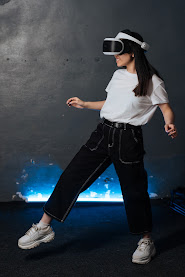Potential And Impacts At Our Lifestyle And On Various Industries of AR/VR Technology. Read entire article to understand potential and impacts of AR/VR Technology on Gaming and Entertainment, Learning and Education, Retail and shopping, Healthccare, Business and Industries.
 |
| @Liceria Info |
We spend a lot of time looking at screens these days.Computers, smartphone and televisions have all becoming a huge part of our lives; they're how we get a lot of our news, use social media, watch ,movies and much more.In this diamong age of technology there have been an innovations an immersive and revolutionary that is non other than augmented reality and virtual reality (AR/VR) technology are changing the way we use screens, creating new and exciting interactive experiences.
So today we'll discuss all about this far-reaching technology and its potential and challenges in simple words what it is and why it is important and impacts at our lifestyle and on various industries/
businesses lets begin with.
Intro and Potential of Augmented and Virtual Reality (AR/VR) Technology
AR/VR technology is an interesting innovation that let us interact with digital content in ways we never thought possible before.With this technology, we can involve ourselves in new worlds, explore unknown places, and experience things that would otherwise be impossible.
This tech has the potential to revolutionize many diffrent industries.It can help us to learn in new ways, by allowing us to experience things directly rather than just reading about them.It can help us to connect with others in new ways, by providing a shared digital space where we can interact and work together.It can help us feel more associated to the world around us, by allowing us to explore new places and see things from new perspectives.
Virtual reality is fully enchanting ecperience that places the users in a digital environment.Using a headset, users can see and interact with a 360 degree view of a virtual world.The headset tracks the user's head movements And adjust the view i real time, creating a sense of presence and realism.
on the other hand augmented reality covers digital content onto the real world.AR can be experienced through a smartphone or tablet screen or AR glasses, which display digital content on a transparent screen.AR content can range from simple graphics to complex 3D models that interact with the physical world.
With virtual reality, you could explore an underwater environment. With augmented reality, you could see fish swimming through the world around you.
 |
| Virtual reality@Liceria Info |
One of the most significant benefits of AR/VR technology is its ability to create immersive and engaging experiences. For example, in gaming, virtual reality allows players to enter the game world and experience it as if it were real. In education, VR can provide enchanting simulations that allow students to learn through experience rather than just reading or watching videos.
Also Read This
Impacts on Various Industries and Businesses
- AR/VR Technology in Gaming and Entertainment
- AR/VR Technology in Learning and Education
- AR/VR Technology in Healthcare
- AR/VR Technology in Retail and Shopping
- Challenges and Limitations of AR/VR Technology
- Business View of AR/VR Technology
- Conclusion
AR/VR Technology in Gaming and Entertainment
AR/VR technology has a important impact on the gaming and entertainment industry. It allows players to experience virtual worlds in a completely fascinating way. With a headset, users can interact with a 360-degree view of a virtual world, creating a sense of presence and realism. This technology can transport players to a different world and give them the feeling of being present in the game.
AR/VR Technology in Learning and Education
AR/VR technology can enhance learning and education by providing involving form that allow students to learn through experience. This technology can create a virtual environment for students to practice skills and gain knowledge. It can also provide an engaging and interactive way for students to learn, making it easier to remember information.
 |
| Education illustrations by augmented reality@Liceria Info |
AR/VR Technology in Healthcare
It has been used in the healthcare to train medical professionals and for pain management in patients. Surgeons can practice complex procedures in a virtual environment, reducing the risk of mistakes during real operations. Patients undergoing painful treaments can use VR to distract themselves from the discomfort.
 |
| @Licera Info |
AR/VR Technology in Retail and Shopping
It is transforming the way we shop and experience products.Funiture retailers are using AR to allow customers to visualize how furniture will look in their home before making a purchase.Car manufacturers are using VR to allow customers to experince a car's interior and features before it is even produced.
Challenges and Limitations of AR/VR Technology
As with any new technology, there are challenges and limitations to AR/VR. One significant challenge is the high cost of the hardware required for a fully immersive experience. Another challenge is the potential for motion sickness, which can occur when the user's physical movements do not match up with what they are seeing in the virtual world. Overcoming these challenges will be essential for AR/VR to become widely adopted and accessible to all.
Business View of AR/VR Tech
As every innovation is a huge opportunity in itself with business point of view, so here we're going to see some statistics of market and future of AR/VR technology.
- The global AR/VR market size was valued at $14.9 billion in 2020 and is expected to reach $62.1 billion by 2026, growing at a CAGR of 28.6%.
- The number of active virtual reality users worldwide is forecasted to reach 171 million by 2024.
- The gaming industry is the largest consumer of VR and AR technologies, accounting for 38% of total revenue in 2020.
- The healthcare industry is the fastest-growing sector in the AR/VR market, with a CAGR of 31.3% from 2020 to 2027.
- In 2020, the COVID-19 pandemic drove increased interest in AR/VR for remote work, virtual events, and online shopping experiences.
- The education sector is also adopting AR/VR technologies, with an expected CAGR of 41.5% from 2020 to 2027.
- The Asia-Pacific region is the fastest-growing market for AR/VR, with a CAGR of 33.2% from 2020 to 2027.
Overall, AR/VR technology is expected to continue growing rapidly across various industries and applications, driven by advancements in hardware and software, increased adoption, and changing consumer preferences.






Awesome great informative it helped a lot to develop a concept of ar vr tech thank you so much
ReplyDelete